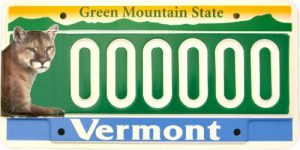Hey everyone,
I’ve been behind with my DDRP efforts but wanted to make amends with a series of posts about what I have been doing. As you might recall, I wrote a pretty ambitious proposal, one informed by a larger project on Puma concolor in North America. Now, I don’t want to abandon the possibilities described in my proposal, but it became apparent that I need a more discrete focus.
And I think I’ve found one in the confluence of cartoons, news reports, and license plates.
 One of the first things I came across in the course of my digital newspaper research was a cartoon from the Boston Globe during the 1950s mocking Vermonters for their conviction pumas — catamounts, to use the regional term — might still haunt the Vermont woods. At that time, pumas had likely abandoned Vermont about a century earlier. (See Fred Copeland, “Vermont’s Panther is Getting Around again,” Daily Boston Globe (1928-1960) Dec 07 1952: 1. ProQuest. 24 Aug. 2017 .)
One of the first things I came across in the course of my digital newspaper research was a cartoon from the Boston Globe during the 1950s mocking Vermonters for their conviction pumas — catamounts, to use the regional term — might still haunt the Vermont woods. At that time, pumas had likely abandoned Vermont about a century earlier. (See Fred Copeland, “Vermont’s Panther is Getting Around again,” Daily Boston Globe (1928-1960) Dec 07 1952: 1. ProQuest. 24 Aug. 2017 .)
But as I did additional digital newspaper research, I saw other instances of stories from Vermont — and about Vermont and Vermonters — encountering pumas. And there was a none-too-subtle tone behind some of the stories which suggested incredulity, sometimes even tripping over into sarcasm. Suddenly, I had the kind of question which delights historians of human-animal relations: What was going on that puma sightings were apparently important to Vermonters, but an object of humor to others?
And, then, I stood downtown one afternoon, looking at a car and its Vermont license plate, and realized this was a still more durable phenomenon: the Vermont conservation plate with its puma made plain how durable this association remains. An association evoked a century — or a century and a half? — after pumas were extinct in the Green Mountain State.
The focus narrows. The wheels turn slowly …